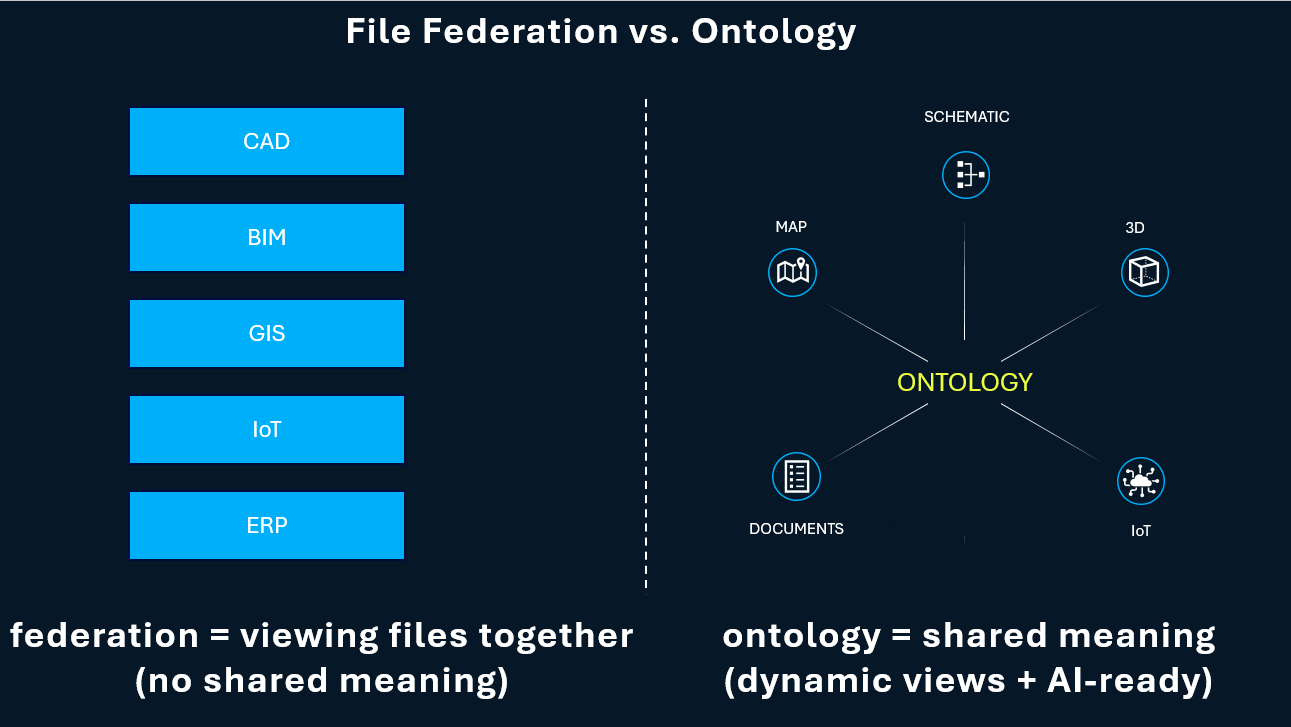
Ontology vs. File Federation: Why the Future of Digital Twins Isn’t About Formats

Digital twins are everywhere in the conversation today — from airports to rail networks, utilities to manufacturing. But not all twins are created equal. The biggest dividing line? Whether they’re built on file federation or on a true ontology.
At Nextspace, we believe this is the single most important choice infrastructure owners and operators will make in the next decade.
The File Federation Trap
Most digital twin platforms today are really file federation tools. They connect CAD, BIM, GIS, IoT, and enterprise databases into a single viewer, allowing teams to see multiple data types side by side.
It’s a useful first step. But there’s a fundamental flaw: federation doesn’t create shared meaning.
· A pipe in BIM doesn’t “understand” a pipe in GIS.
· An IoT sensor reading can’t connect itself to a work order in Maximo.
· A 3D model doesn’t explain how it relates to a document, a schematic, or a simulation.
You get a better picture, but not a better understanding. And without shared semantics, AI, automation, and simulation remain out of reach.
Ontology: A Model of Meaning
Ontology takes a different path. Instead of stacking files together, it creates a unified model of entities, attributes, and relationships across all systems.
In practice, this means:
· Unified semantics → BIM, GIS, IoT, ERP, and financial data are harmonized into one living knowledge graph.
· Dynamic visual proxies → every entity can be represented as a 2D schematic, a map, a 3D model, or a document — all cross-referenced automatically.
· Temporal dimension → every attribution is time-stamped, so systems can be animated across past, present, and future for simulation and analytics.
· Human + AI bridge → humans interact through intuitive visual interfaces; AI agents connect through APIs and MCP endpoints.
The result isn’t just a viewer of files. It’s a digital twin that understands itself.
Why This Matters
For infrastructure owners and operators, the difference is profound:
· AI-readiness: Ontology makes data usable for machine learning, LLMs, and simulation pipelines.
· Decision confidence: Engineers, planners, and executives see the same truth, in the mode that makes most sense to them.
· Faster deployment: Ontology reduces integration complexity — moving from months of data wrangling to hours of semantic alignment.
· Future resilience: File formats change. Ontology endures.
Nextspace’s View
We’ve lived both sides of this. In our aerospace and defence heritage, we built some of the most advanced file-format translation and federation tools in the world. And we learned a hard truth: no file format, no matter how universal, can unlock the full value of digital twins.
That’s why Nextspace is ontology-first. We unify meaning, not just files. We make data simultaneously human-friendly and AI-ready. And we’ve designed our visual proxies and temporal ontology to make this practical, scalable, and ready for the challenges of global infrastructure.
The Takeaway
The future of digital twins isn’t about formats. It’s about meaning.
File federation can show your data together. Ontology makes your data work together.
That’s the difference between a digital twin that looks impressive and one that delivers lasting value.



